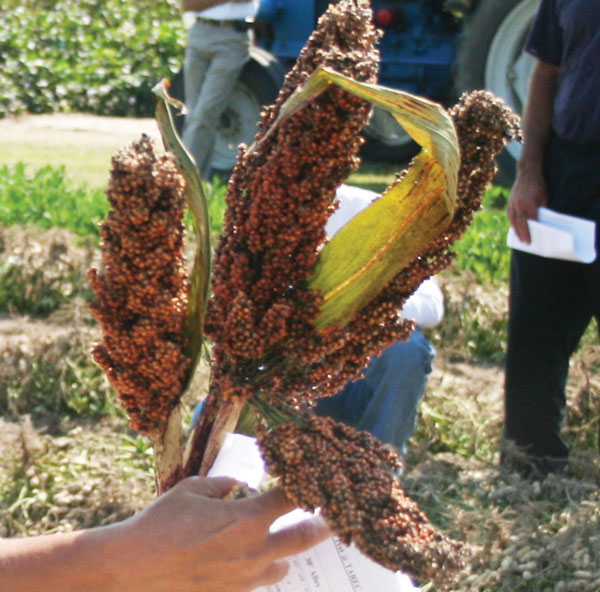
Zinc deficiency can reduce sorghum yields, lower test weights
• The usual suspects include nitrogen deficiency, disease, or even herbicide burn, but last year in North Carolina some of the yellowing problems came from zinc deficiency, and in some cases on soils that showed adequate amounts of zinc, based on soil samples.
July 15, 2013

There is no doubt grain sorghum acreage will go up this year in the Carolinas, some contend as much as 150,000 acres in the two states, and one problem to watch out for is yellowing of the crop once it gets up and growing.
The usual suspects include nitrogen deficiency, disease, or even herbicide burn, but last year in North Carolina some of the yellowing problems came from zinc deficiency, and in some cases on soils that showed adequate amounts of zinc, based on soil samples.
The rapid increase in grain sorghum in North Carolina has prompted North Carolina State Corn Specialist Ronnie Heiniger to work with the crop. He says he got a number of calls early in the growing season last year about yellowing areas in grain sorghum fields.
“My first thought was it must be a pH problem or nitrogen deficiency. In this one particular field, the pH was good and the grower had used 150-160 pounds of nitrogen per acre in the field. That led us to look at other causes and way down the list was zinc deficiency,” Heiniger says.
Again, based on soil sample results, the field showed zinc in the 30 range, which should have been adequate for grain sorghum at that stage of growth. In this case the soil sample was correct, but not for the grain sorghum in the field.
“We applied six pounds of zinc (two pounds actual ingredient) per acre in a foliar spray on this particular field. Within 7-10 days it had regained its green color and by harvest it was close, if not exactly, caught up to other areas of the field not affected by a lack of zinc,” he adds.
Grain sorghum is a very slow growing, spindly crop in the early stages, and evidently it doesn’t take up zinc very efficiently. And, based on looking at other growers fields, the same seems to be true for sulfur.
Heiniger says there were a number of grain sorghum fields last year that were hurt by either or both zinc and sulfur deficiencies.
Essential for plant growth
Zinc is an essential nutrient for plant growth, involved in protein synthesis and necessary for growth regulation and enzyme systems. Plants absorb zinc as inorganic cations, which are held on exchange sites on clay and organic matter.
Zinc plays a vital role in a plant's ability to use nitrogen and transform it into yield and protein. As was the case in the North Carolina field, zinc deficiency prevented the grain sorghum from properly utilizing the available nitrogen, which can often influence growers to add more nitrogen to a yellowing crop.
Zinc deficiency is not unusual in other crops, particularly in corn. However, for most row crop growers in the Upper Southeast, grain sorghum is essentially a new crop.
The information available on grain sorghum production will take a few years to catch up with the huge increase in acreage. For example, in North Carolina, in 2011 there was only about 15,000 acres of grain sorghum harvested. This year 100,000 acres or more is possible.
Detecting Zinc deficiency is not always easy, even with soil testing. While levels of zinc in the soil may be adequate for corn or other fast growing crops, it is important to remember that grain sorghum, especially in the early going, is a notoriously slow growing crop.
For growers using poultry litter, and to a lesser degree cow or hog manure as a fertilizer source, zinc deficiency is likely to be less of a problem, regardless of the crop grown.
For example, North Carolina grower Travis Starnes hit 90 bushels of soybeans per acre last year using turkey litter as his source of fertilizer.
Zinc can be banded as a starter or broadcast and incorporated with equal response.
Banded zinc rates can be lower than broadcast rates because of greater efficiency. However, residual zinc levels
will be lower from banded than broadcast applications.
Several sources of zinc fertilizer are available. Zinc sulfate and liquid zinc products are the most common sources.
Liquid zinc products
Liquid zinc products include chelates, lignin sulfonates plus polyflavonoids, and zinc-ammonium complexes.
In tests in the Midwest Zinc chelate (EDTA) banded as a starter was more efficient than other sources, and zinc rates can be reduced by half or three-quarters compared to the full recommended rates with similar performance.
Grain sorghum probably gets a bad rap for its inability to take up and use nitrogen. Research in other parts of the U.S. has shown the crop to be an excellent scavenger of available nitrogen. In many cases nitrogen deficiency has clearly been confused with zinc deficiency.
Heiniger says he saw some grain sorghum fields last year that also had sulphur deficiencies. In most grain sorghum producing areas, sulphur is adequate for best sorghum yields, but on some lighter, sandy soils, characteristic of the coastal areas of the Upper Southeast, deficiencies may be a limiting factor in grain sorghum production.
In some of the sandy soils in the Carolinas, Heiniger says 10-12 pounds of additional sulfur per acre may be needed to produce a top yielding crop.
The North Carolina State specialist says other factors, not associated with crop nutrition, can likewise be limiting factors in grain sorghum production in the region.
“Grass can be the Achilles Heel of grain sorghum production,” Heiniger says. “Grain sorghum is just not a fast grower — it’s slow and spindly — and doesn’t do a good job of covering rows and shading out grass and weeds. This can be an especially big problem on wider row spacings,” he adds.
Though grain sorghum has been widely promoted by Murphy-Brown and other grain buyers as a good double-crop with wheat, Heiniger says about 65 percent of the crop last year in North Carolina was grown as a conventional, May-planted crop.
The better results, he says, came from later-planted sorghum, planted behind wheat. “Grain sorghum is a lot like corn, if you knew when it would rain, you could consistently produce 100 bushels per acre,” he says.
“Choosing the right hybrid — one that is best suited to your particular farming operation and by all means planting hybrids with good disease resistance — are other keys to growing high yields of grain sorghum with high test weights,” Heiniger adds.
Want access to the very latest in agriculture news each day? Subscribe to Southeast Farm Press Dail
More from Southeast Farm Press
Alabama Agricultural and Rural Crimes Unit officially established
Black Sea wheat roller coaster continues
What should I do with flooded cotton field?
Tyron Spearman inducted into Peanut Hall of Fame
About the Author(s)
You May Also Like





